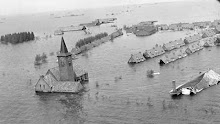>>Mediterranean Sea:
18 - 21 February 1946
We were heading for Port Said in Egypt and passed Stromboli and through the Straits of Messina on 19 February. Watching from the deck of the Orbita I saw mainly gulls of the same species as at Toulon and a few far-off ducks. The only land birds were a Lapwing and apparent Skylark. >>>
>>France, Toulon
17 February 1946
"Arrived here c. 0600, boarded R.M.S. Orbita in harbour and sailed about 1600." R.M.S. signifies "Royal Mail Ship". This was before the days of regular airmail: most letters were sent by "surface mail" and took much longer to reach their destination.>>>
"In town, House Sparrows only identified.
In harbour I saw my first Yellow-legged [Herring] Gulls* (Larus argentatus cachinans [= L. michahellis]). These were plentiful and nearly all adults. They were distinguished by darker mantle than Herring Gulls (L. a. a.) (appearing almost as dark as British Lesser Black-backed Gulls (L. fuscus graellsii) in some lights and at certain angles) and very yellow or orange-yellow legs (very good feature this). No noticeable markings on crown or nape.
Also plentiful were my first Mediterranean [Black-headed] Gulls* (L. melanocephalus). Adults were similar to the typical species (L. ridibundus) but apparently had less white in the leading edge of the wing - immatures were seen to have darker trailing edge. Some adults had almost black hoods.
Yellow-legged Gulls followed us all day but Mediterranean Gulls for only a few miles from port."
Life-list now 164 species.
>>France, Dieppe A to Toulon D via Limoges B and Toulouse C
16 February 1946
View Larger Map
This was my first experience of a foreign country. Though we were mostly kept from direct contact with French people, I noticed that many airmen were flogging (bartering) their blankets out of the train windows. It was only about a year since the Germans had been driven from France and presumably good quality blankets were in short supply.
All the observations reported on this day were from a moving train. With the shaking, speed and glass, conditions were far from ideal.
From this date, though most birds were still familiar, some were new and I began to find birds I could not immediately identify. The field guide (not a term in use then) I had with me was a book on British birds, though I was able to supplement it later with other books. However, some species remained unidentified till I returned to England and could consult top reference works at the Natural History Museum in London. A few species remain unidentified to this day! I was always careful to note down a description of such species and would be grateful for opinions on their identity.
Also I would appreciate opinions on the route the train took in northern France as I am unable to locate on any map four of the towns mentioned below: Neuilly Pailaux, St Sebastian, Forgeville & Russac.
“By train all day from Neuilly Pailaux to Bram (dawn to dusk) via Limoges, Toulouse.>>>
Magpie, principal species. Present all areas except hills of moderate height. Numbers seen between various towns as follows: Dieppe - 39 - St Sebastian - 10 - Forgeville - 40 - Russac - 27 - Cahors - 62 - Toulouse - 83 - Bram [20 km W Carcassonne]. The first leg (to St S.) was short in daylight and distribution pretty intense (country flatish). Then smaller numbers (particularly Limoges to Cahors where hills highest). Thickest distribution, Toulouse - Bram (short distance), parties of c. 11 and c. 12 (country flat and low). Particularly in the south, pairs noticeable.
On all types of ground and throughout the day, Rooks (plenty) and some Jackdaws, were seen. Several Jays were spotted in the south. They differed visibly from the British form and were Continental Jays (G. g. glandarius). Noticeable differences were larger, more rufous and brighter appearance. White wing-bar and rump most noticeable as were black wing and tail. Under tail white. No particular blue in wing or mark on face noticed though possibly dark eye stripe.
At various points other species seen were Green Woodpeckers (most frequent in S), Chaffinches (Continental - f.c.c.), Skylarks and a few Blackbirds and House Sparrows.
Harriers (?) were seen: one probable ♀Hen Harrier though too far off to be certain, hunting over farm and woodland near Dieppe. Another, not Hen, near Toulouse. Back and wings seemed to have a blueish tinge though brown tipped, rather small.
In the hills were several buzzards or kites, five being visible at once on one occasion. One seemed to have black wing tips but little detail was visible and most seemed uniform dark brown.
Other species noted: Fieldfares (or Missel Thrushes), a probable Wood-Lark (by tail) near St. Sebastian and a Great Tit heard singing.”
Subscribe to:
Post Comments (Atom)


No comments:
Post a Comment